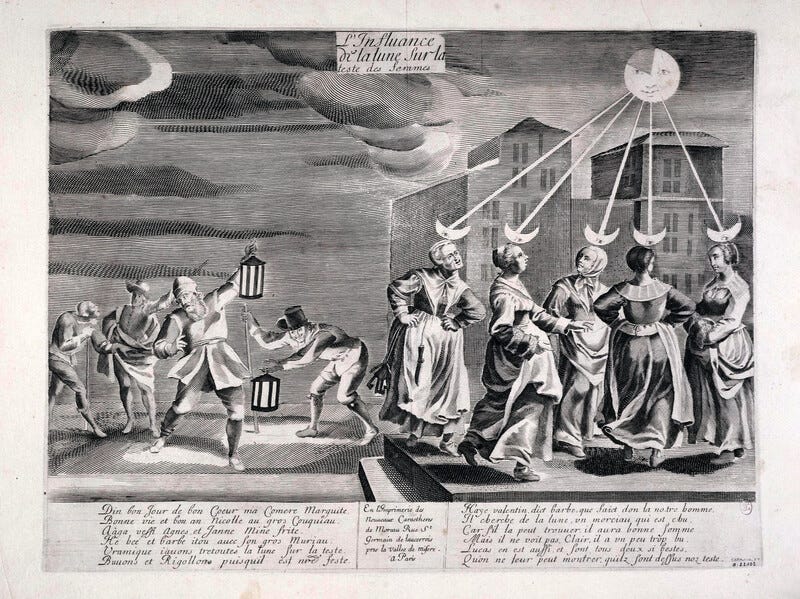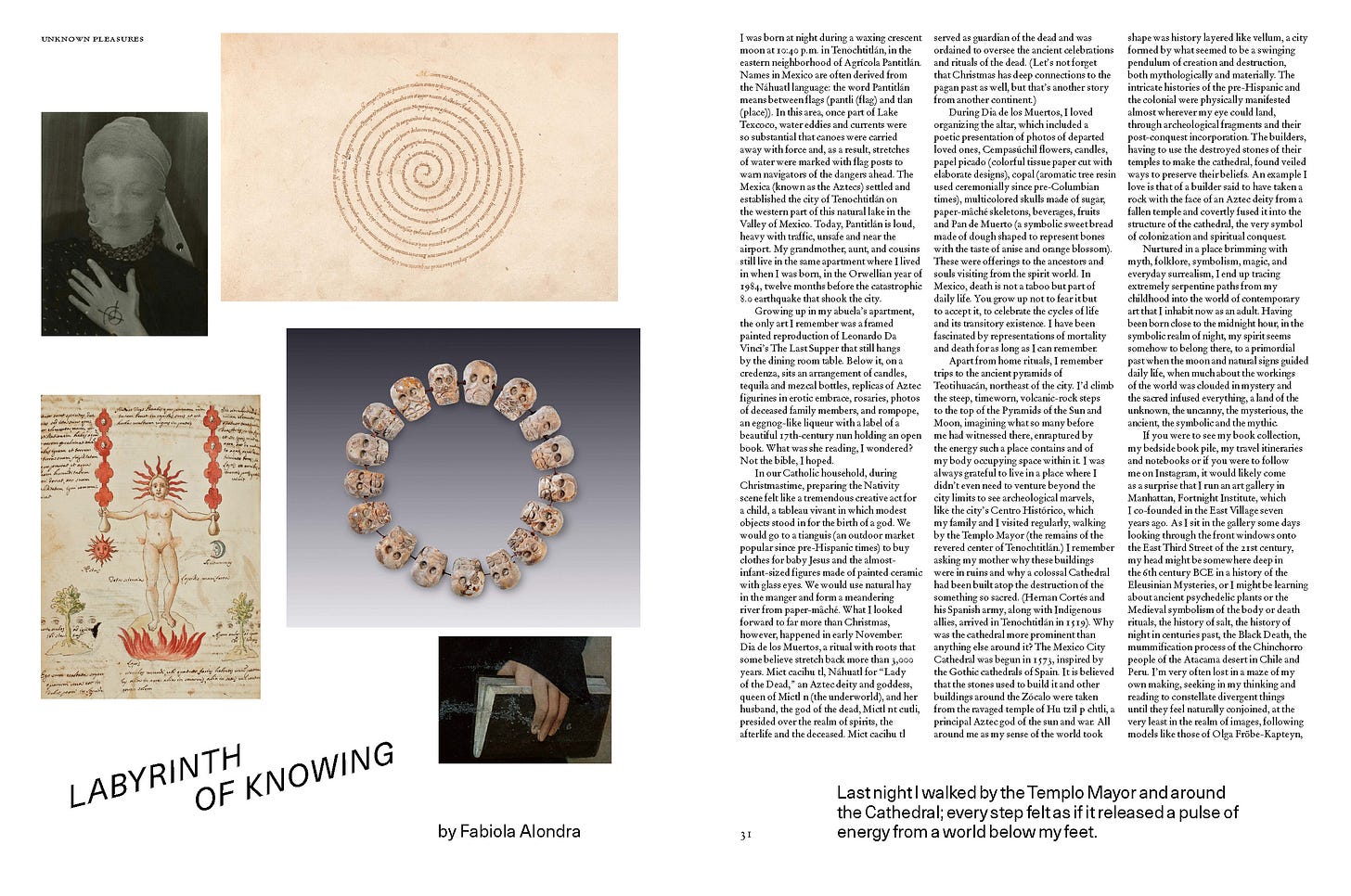Labyrinth of Knowing
In this essay, I examine how my upbringing in Mexico City shaped my visual culture and worldview, influenced by a synthesis of Catholic, Indigenous, and supernatural imagery.
Essay for Issue 9 of Ursula Magazine. November 2023.
I was born at night during a waxing crescent moon at 10:40 p.m. in Tenochtitlán, in the eastern neighborhood of Agrícola Pantitlán. Names in Mexico are often derived from the Náhuatl language: the word Pantitlán means between flags (pantli [flag] and tlan [place]). In this area, once part of Lake Texcoco, water eddies and currents were so substantial that canoes were carried away with force, and, as a result, stretches of water were marked with flagposts to warn navigators of the dangers ahead. The Mexica (known as the Aztecs) settled and established the city of Tenochtitlán on the western part of this natural lake in the Valley of Mexico. Pantitlán is loud, heavy with traffic, unsafe, and near the airport today. My grandmother, aunt, and cousins still live in the same apartment I lived in when I was born, in the Orwellian year of 1984, twelve months before the catastrophic 8.0 earthquake that shook the city.
Growing up in my abuela’s apartment, the only art I remember was a framed painted reproduction of Leonardo Da Vinci’s Last Supper that still hangs by the dining room table. Below it, on a credenza, sits an arrangement of candles, tequila, and mezcal bottles, replicas of Aztec figurines in erotic embrace, rosaries, photos of deceased family members, and rompope, an eggnog-like liqueur with a label of a beautiful 17th-century nun holding an open book. What was she reading, I wondered? Not the Bible, I hoped.
In our Catholic household, during Christmastime, preparing the Nativity scene felt like a tremendous creative act for a child, a tableau vivant in which modest objects stood in for the birth of a god. We would go to a tianguis (an outdoor market popular since pre-Hispanic times) to buy clothes for baby Jesus and the almost infant-size figures made of painted ceramic with glass eyes. We would use natural hay in the manger and form a meandering river from papier-mâché. What I looked forward to far more than Christmas happened in early November: Día de los Muertos, a ritual with roots that some believe stretch back more than 3,000 years. Mictēcacihuātl, whose name is Náhuatl for “Lady of the Dead,” an Aztec deity and goddess, queen of Mictāl (the underworld), and her husband, the god of the dead, Mictlāntēcutli, presided over the realm of spirits, the afterlife and the deceased. Mictēcacihuātl served as guardian of the dead and was ordained to oversee the ancient celebrations and rituals of the dead. (Let’s not forget that Christmas has deep connections to the pagan past as well, but that’s another story from another continent.)
During Día de los Muertos, I loved organizing the altar, which included a poetic presentation of photos of departed loved ones, cempasúchil flowers, candles, papel picado (colorful tissue paper cut with elaborate designs), copal (aromatic tree resin used ceremonially), multicolored skulls made of sugar, papier-mâché skeletons, beverages, fruits and Pan de Muerto (a symbolic sweet bread made of dough shaped to represent bones with the taste of anise and orange blossom). These were offerings to the ancestors and souls visiting from the spirit world. In Mexico, death is not a taboo but part of daily life. You grow up not to fear it but to accept it, to celebrate the cycles of life and its transitory existence. I have been fascinated by representations of mortality and death for as long as I can remember.
Apart from home rituals, I remember trips to the ancient pyramids of Teotihuacán, northeast of the city. I’d climb the steep, timeworn, volcanic-rock steps to the top of the Pyramids of the Sun and Moon, imagining what so many before me had witnessed there, enraptured by the energy such a place contains and of my body occupying space within it. I was grateful to live in a place where I didn’t need to venture beyond the city limits to see archeological marvels, like the Centro Histórico, which my family and I visited regularly, walking by the Templo Mayor (the remains of the revered center of Tenochtitlán.) I remember asking my mother why these buildings were in ruins and why a colossal cathedral had been built atop the destruction of something so sacred. (Hernan Cortés and his Spanish forces, along with Indigenous allies, arrived in Tenochtitlán in 1519). Why was the cathedral more prominent than anything else around it? Mexico City’s Metropolitan Cathedral was begun in 1573, inspired by the Gothic cathedrals of Spain. It is believed that the stones used to build it and other buildings around the Zócalo were taken from the ravaged temple of Huītzilōpōchtli, a principal Mexica god of the sun and war. All around me, as my sense of the world took shape, was history layered like vellum, a city formed by what seemed to be a swinging pendulum of creation and destruction, both mythologically and materially. The intricate histories of the pre-Hispanic and colonial were physically manifested almost wherever my eye could land through archeological fragments and their post-conquest incorporation. The builders, having had to use the destroyed stones of their temples to make the cathedral, found veiled ways to preserve their beliefs. An example I love is that of a builder said to have taken a rock with the face of a deity from a fallen temple and covertly fused it into the cathedral's structure, the very symbol of colonization and spiritual conquest.
Nurtured in a place brimming with myth, folklore, symbolism, magic, and everyday surrealism, I traced incredibly serpentine paths from my childhood into the world of contemporary art I inhabit now as an adult. Having been born close to the midnight hour, in the symbolic realm of night, my spirit seems somehow to belong there, to a primordial past when the moon and natural signs guided daily life, when much about the workings of the world was clouded in mystery and the sacred infused everything, a land of the unknown, the uncanny, the mysterious, the ancient, the symbolic and the mythic.

If you were to see my book collection, my bedside book pile, my travel itineraries, and my notebooks- or if you were to follow me on Instagram- you might be surprised to learn that I run an art gallery in Manhattan, Fortnight Institute, which I co-founded in the East Village seven years ago. As I sit in the gallery some days, looking through the front windows onto East Third Street of the 21st century, my mind may drift deep into the 6th century BCE, immersed in the history of the Eleusinian Mysteries, ancient psychedelic plants, medieval symbolism of the body, death rituals, the history of salt, the night's history from centuries past, the Black Death, and the mummification process of the Chinchorro people of the Atacama Desert in Chile and Peru. I’m very often lost in a labyrinth of my own making, seeking in my thinking and reading to constellate divergent things until they feel naturally conjoined, at the very least in the realm of images, following models like those of Olga Fröbe-Kapteyn, the Dutch scholar and spiritualist, and Aby Warburg, the founder of the wholly unclassifiable Warburg Institute in London. (As Warburg wisely told us: “God is in the details.”) In addition to my obsessive image collection, I keep many small notebooks of lists, definitions, quotations, and phrases, fragments shored against my ruins, as Eliot put it. Below are some examples:
Oreibaia
Possession trance
Ritual of Inversion
Orpheotelestae
Teratology
Tolle Lege!
Disciple of Experience
Psithurism
Querent
William Blake’s Twofold Vision
Catenation of Ideas
Medieval Synthesis
Rainbow Body
The Yawanawa
The Gateless Gate
The Cosmic Tree
To Untie the Wine Skin
Ocote
Hecate
The Ancient Chullpa of Peru
Teonanacatl
Lapidaries
Hierophany
As disparate as my worlds can feel, I usually see only a thin, delicate veil separating them, which now and again blows ritualistically to the side at the slightest whisper or murmur of wind. At its best, art achieves what the most esoteric knowledge does, prolonging the arrival of resolved meaning as a way of perpetuating wonder and curiosity in a world that often feels devoid of the sacred and the mysterious. In the end, I am drawn to images and objects, old or new, that keep us on the borderlands of the rational.
The title of this essay refers to a book that profoundly influenced me in my twenties: Labyrinths, a collection of short stories by Jorge Luis Borges that serves as an encyclopedia of imaginary places where the boundaries between reality and fiction remain ambiguous and often intertwined. My mind frequently drifts like a character would in a Borgesian world, perhaps the character of an archaeologist mapping a lost city. If I hadn’t wandered into the professional world of art publications and galleries as a young woman, I almost certainly would have become an archeologist to absorb the energy that historical objects, archeological complexes, and the art of the past radiate. That we can see, smell, and sometimes touch the past is astonishing to me; it offers a chance to understand how transient we are and how long art and the objects of our past outlive us. As Mexican historian Alfredo López Austin says: “Some people come to history by way of aesthetic emotion. A word, a sculpture, or a pattern can be the igniting spark.”
Last night, I walked by the Templo Mayor and around the cathedral; every step felt like it released a pulse of energy from a world below my feet. The closer I came to the temple ruins, the stronger the power grew. Surrounded by volcanic stones like tezontle and tuff rocks used to build Tenochtitlán, I thought about the myths of Mexico’s volcanoes. As I write this, back again for a while in Mexico City, I can see in the distance and sense in my bones the omnipotent presence of Popocatépetl (the Smoking Mountain), the volcano overlooking the Valley of Mexico, its breath actively painting the skies with smoke. Near Popocatépetl lies another volcano, Iztaccíhuatl, or as I grew up knowing it, La Mujer Dormida. Popocatépetl and Iztaccíhuatl were lovers in Mexica (Aztec) mythology. When Iztaccíhuatl was falsely informed that Popocatépetl had died, she died as well, of grief, and upon his return, the gods covered the pair in snow and turned them into mountains. Today, Popocatépetl is a dangerously active volcano, still bringing fire to Earth as he mourns his beloved, keeping myth and magic, life and death, in our presence and the present.












This is one of the most beautifully written pieces I’ve read on substack! Thank you for sharing 🫶🏼
Thank you!